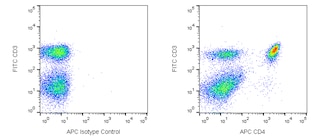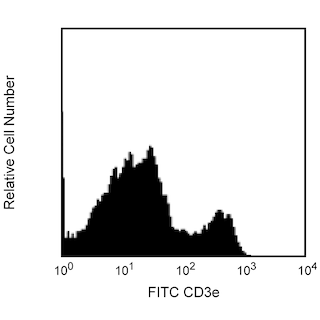Old Browser
Looks like you're visiting us from {countryName}.
Would you like to stay on the current country site or be switched to your country?




Flow cytometric analysis of CCR7 (CD197) on mouse splenocytes and thymocytes. Freshly isolated mouse spleen or thymus cells were stained with PerCP-Cy™5.5 Rat Anti-Mouse CD197 (CCR7) (Cat. No. 560812), APC Rat Anti-Mouse CD4 (Cat. No.553051) and FITC Hamster Anti-Mouse CD3e (Cat. No. 553062). Two-color flow cytometric dot plots showing the correlated expression patterns of CD3 (left panel) or CD4 (middle panel) versus CCR7 (CD197) on splenocytes and CD3 versus CCR7 (right panel) on thymocytes are shown. The dot plots were derived from gated events with the forward and side light-scatter characteristics of viable lymphocytes or thymocytes. Flow cytometry was performed using a BD LSR™ II flow cytometry system.


BD Pharmingen™ PerCP-Cy™5.5 Rat Anti-Mouse CD197 (CCR7)

Regulatory Status Legend
Any use of products other than the permitted use without the express written authorization of Becton, Dickinson and Company is strictly prohibited.
Preparation And Storage
Product Notices
- Since applications vary, each investigator should titrate the reagent to obtain optimal results.
- Please observe the following precautions: Absorption of visible light can significantly alter the energy transfer occurring in any tandem fluorochrome conjugate; therefore, we recommend that special precautions be taken (such as wrapping vials, tubes, or racks in aluminum foil) to prevent exposure of conjugated reagents, including cells stained with those reagents, to room illumination.
- PerCP-Cy5.5 is optimized for use with a single argon ion laser emitting 488-nm light. Because of the broad absorption spectrum of the tandem fluorochrome, extra care must be taken when using dual-laser cytometers, which may directly excite both PerCP and Cy5.5™. We recommend the use of cross-beam compensation during data acquisition or software compensation during data analysis.
- PerCP-Cy5.5–labelled antibodies can be used with FITC- and R-PE–labelled reagents in single-laser flow cytometers with no significant spectral overlap of PerCP-Cy5.5, FITC, and R-PE fluorescence.
- Please refer to www.bdbiosciences.com/us/s/resources for technical protocols.
- For fluorochrome spectra and suitable instrument settings, please refer to our Multicolor Flow Cytometry web page at www.bdbiosciences.com/colors.
- An isotype control should be used at the same concentration as the antibody of interest.
- Caution: Sodium azide yields highly toxic hydrazoic acid under acidic conditions. Dilute azide compounds in running water before discarding to avoid accumulation of potentially explosive deposits in plumbing.
- Cy is a trademark of Amersham Biosciences Limited. This conjugated product is sold under license to the following patents: US Patent Nos. 5,486,616; 5,569,587; 5,569,766; 5,627,027.
- This product is subject to proprietary rights of Amersham Biosciences Corp. and Carnegie Mellon University and made and sold under license from Amersham Biosciences Corp. This product is licensed for sale only for research. It is not licensed for any other use. If you require a commercial license to use this product and do not have one return this material, unopened to BD Biosciences, 10975 Torreyana Rd, San Diego, CA 92121 and any money paid for the material will be refunded.
Companion Products




The monoclonal antibody 4B12/CCR7 reacts with the mouse C-C chemokine receptor type 7 (CCR7). CCR7 is also known as CD197 (previously known as EBI1, Ebi1h and CMKBR7) and plays a central role in mediating homeostatic B and T lymphocyte trafficking to and within secondary lymphoid tissues. CD197 is a seven-transmembrane, G-protein-coupled, 43 kDa glycoprotein receptor that is specific for the CC chemokines, MIP3ß/Exodus-3/ELC/CKb11/Scya19/CCL19 and 6Ckine/Exodus-2/SLC/TCA4/CKb9/Scya21/CCL21. The mouse Ccr7 gene is located on chromosome 11. CD197 (CCR7) is differentially expressed by subsets of thymocytes. Positive CD197 expression appears to be involved in the cortex-to-medulla migration of positively-selected thymocytes wherein they complete functional maturation including the establishment of central tolerance. It is most highly expressed by some mature medullary single-positive thymocytes. CD197 is also expressed by subsets of mature peripheral CD4+ and CD8+ T lymphocytes including naïve and regulatory T cells and central memory T cells. In addition, it is differentially expressed by subsets of B lymphocytes, dendritic cells, and Langerhans cells. CD197 serves as a homing receptor that helps guide these various cell types to and within lymphoid tissues. In this way, CCR7 supports protective immunity while safeguarding self tolerance. Reportedly, the 4B12/CCR7 antibody is not agonistic, is not blocked by CCL21 nor by physiologic levels of CCL19, nor does the antibody block the binding of CCL21 to CCR7. The immunogen used to generate the 4B12 hybridoma was a mouse CCR7-transfected rat cell line.

Development References (6)
-
Britschgi MR, Link A, Lissandrin TK, Luther SA. Dynamic modulation of CCR7 expression and function on naive T lymphocytes in vivo. J Immunol. 2008; 181(11):7681-7688. (Clone-specific: Flow cytometry). View Reference
-
Forster R, Davalos-Misslitz AC, Rot A. CCR7 and its ligands: balancing immunity and tolerance. Nat Rev Immunol. 2008; 8(5):362-371. (Biology). View Reference
-
Kurobe, H., Liu, et al. CCR7-dependent cortex-to-medulla migration of positively selected thymocytes is essential for establishing central tolerance. Immunity. 2006; 24(2):165-177. (Biology). View Reference
-
Ohl L, Mohaupt M, Czeloth N, et al. CCR7 governs skin dendritic cell migration under inflammatory and steady-state conditions. Immunity. 2004; 21(2):279-288. (Clone-specific: Flow cytometry). View Reference
-
Ritter U, Wiede F, Mielenz D, Kiafard Z, Zwirner J, Korner H. Analysis of the CCR7 expression on murine bone marrow-derived and spleen dendritic cells.. J Leukoc Biol. 2004; 76(2):472-476. (Clone-specific: Flow cytometry). View Reference
-
Schweickart VL, Raport CJ, Godiska R, et al. Cloning of human and mouse EBI1, a lymphoid-specific G-protein-coupled receptor encoded on human chromosome 17q12-q21.2. Genomics. 1994; 23(3):643-650. (Biology). View Reference
Please refer to Support Documents for Quality Certificates
Global - Refer to manufacturer's instructions for use and related User Manuals and Technical data sheets before using this products as described
Comparisons, where applicable, are made against older BD Technology, manual methods or are general performance claims. Comparisons are not made against non-BD technologies, unless otherwise noted.
For Research Use Only. Not for use in diagnostic or therapeutic procedures.
Refer to manufacturer's instructions for use and related User Manuals and Technical Data Sheets before using this product as described.
Comparisons, where applicable, are made against older BD technology, manual methods or are general performance claims. Comparisons are not made against non-BD technologies, unless otherwise noted.
Report a Site Issue
This form is intended to help us improve our website experience. For other support, please visit our Contact Us page.